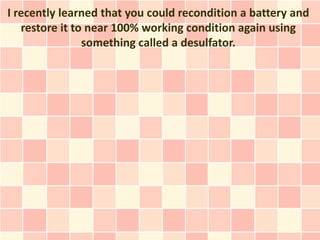
Recondition Battery
- 1. I recently learned that you could recondition a battery and restore it to near 100% working condition again using something called a desulfator.
- 2. It had been something that I had been trying to figure out for quite some time. I'm sure that you've noticed that over time any battery that you use seems to hold less of a charge (it dies quicker). For most household rechargeable batteries this really isn't a big deal because they don't really cost that much to replace.
- 3. In the case of lead acid batteries though... they can cost upwards of $100 to replace and I really wanted to find out some way to make them last longer. After quite a long time of searching I finally learned about battery reconditioning.
- 4. Battery reconditioning is a very interesting process. Basically, you hook up a desulfator (which also goes by the name nanopulser) and over time it rejuvenated your old battery to 100% working condition again.
- 5. First, you should learn exactly why your lead acid batteries stop working in the first place. As you charge and discharge a deep cycle battery it begins to build up sulfates on the lead plates in the battery. When these sulfates start sticking to the plates instead of floating around in the acid your battery starts to hold less of a charge. If nothing is done enough of these sulfates build up and eventually the battery will simply not hold a charge anymore.
- 6. That is... unless you decide to recondition it. Basically what a battery reconditioner does is send high amperage extremely fast pulses of energy into the battery. These pulses break up the sulfates that have stuck on to the lead plates in the battery and they once again dissolve back in to the battery acid.
- 7. Generally, battery reconditioning happens over a period of 1 - 3 weeks. The process is as follows:
- 8. The very first thing you do is hook up your battery charger to the battery and do a full charge. Once it's fully charged you then unhook the battery and let it sit for 8 - 10 hours. After it's done sitting get your multimeter out and take a voltage reading. As long as it reads above 10.6 volts than it means that this battery is a good candidate for reconditioning.
- 9. Now you hook the battery reconditioner up to the battery and let it do it's thing for a couple of days (make sure to leave the charger hooked up on trickle charge). After that, you fully discharge the battery and charge it back up again. Take a voltage reading and keep repeating this process until you reach 13.6 volts to 14.8 volts (depending on your battery) reading on your multimeter.
- 10. The nice thing about battery reconditioning is that as long as you take care of your batteries you can keep reconditioning them until they get a shorted or open cell. That means instead of your batteries lasting you 2 - 5 years they could last you 10 or more years (with proper care).
- 11. Is learning how to recondition a battery worth it? Definitely! After you recondition your first battery you'll be saving $90 for every single battery that you recondition afterwards.